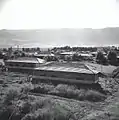Beit HaShita
בֵּית הַשִּׁטָּה | |
|---|---|
 Beit HaShita | |
| Etymology: House of the Acacia | |
 Beit HaShita  Beit HaShita | |
| Coordinates: 32°33′15″N 35°26′15″E / 32.55417°N 35.43750°E | |
| Country | |
| District | Northern |
| Council | Gilboa |
| Affiliation | Kibbutz Movement |
| Founded | 12 December 1935[1] |
| Founded by | Kvutzat HaHugim/Tnuat HaMahanot HaOlim members |
| Population (2021)[2] | 1,258 |
| Website | www.beithashita.org.il |
Beit HaShita (Hebrew: בֵּית הַשִּׁטָּה, lit. House of the Acacia) is a kibbutz in northern Israel, under the jurisdiction of Gilboa Regional Council. As of 2021 it had a population of 1,258.[2]
Geography
The built-up area of Beit Hashita ranges from 70 meters below sea level to sea level.[3]
History
Source:[4]
Ceramics and coins from the Byzantine era were found in the region of Beit Hashita.[5]
The kibbutz traces its origin to a group meeting held in Hadera in 1928, by "Kvuzat HaHugim" of the HaMahanot HaOlim movement from Haifa and Jerusalem.[6] The first members lived at nearby Ein Harod until 1934, when establishment of the kibbutz began at its present location about 1 km east of Shatta.[6]
The land of the kibbutz was purchased by the Palestine Land Development Company from its Arab owners in 1931.[7][8]
The kibbutz was later named after the biblical town Beit Hashita, where the Midianites fled after being beaten by Gideon (Judges 7:22),[9][10] thought to be located where Shatta was. It falls under the jurisdiction of Gilboa Regional Council.
In the 1945 statistics, Beit hash Shitta had 590 inhabitants, all Jews. It was noted that Shatta was an alternative name.[11][12]
.-JNF045560.jpeg.webp) Beit HaShita 1940
Beit HaShita 1940.-JNF045559.jpeg.webp) Beit HaShita 1940
Beit HaShita 1940 Beit HaShita 1945
Beit HaShita 1945 Palmach camp at Beit HaShita, 1947
Palmach camp at Beit HaShita, 1947
Post-1948
In 1948, Beit HaShita took over 5,400 dunams of land from the newly depopulated Arab villages of Yubla and Al-Murassas.[13]
Eleven kibbutz members fell during the 1973 Yom Kippur War, the largest number as a percentage of the population than any other town in Israel.[14]
Economy
Beit Hashita produced cotton, wheat, melons, olives and citrus fruits. There was also a dairy barn, chickens and a fish farm. In the 1960s, Beit HaShita established a pickling factory which produces and markets pickles, olives and pickled vegetables under the brand name Beit HaShita.[15] The factory also produces syrups for making juices under the brand name Vitaminchick. The factory was bought from the kibbutz in 1998 by the Israeli food manufacturer, Osem.[16]
Religion and culture
The Kibbutz Institute for Holidays and Jewish Culture, an organization that preserves the cultural heritage of the kibbutz, was established by kibbutz member Aryeh Ben-Gurion, nephew of Israeli Prime Minister David Ben-Gurion.[17] Beit Hashita served as the basis for the 1981 English language book Kibbutz Makom, which described the kibbutz society.[18] Many of the member families of the kibbutz are secular. There is however a small orthodox synagogue.
Notable people
References
- ↑ State of Israel (1952) Supplement page III
- 1 2 "Regional Statistics". Israel Central Bureau of Statistics. Retrieved 22 February 2023.
- ↑ Survey of Israel, Topographic map
- ↑ Mills, 1932, p. 80
- ↑ Dauphin, 1998, p. 776
- 1 2 "Historical summary on kibbutz website". Archived from the original on 2015-11-23. Retrieved 2015-09-08.
- ↑ Stein, 1984, pp. 125,134,263–264.
- ↑ Kark, 1997
- ↑ Carta's Official Guide to Israel and Complete Gazetteer to all Sites in the Holy Land. (3rd edition 1993) Jerusalem, Carta, p.110 , ISBN 965-220-186-3 (English)
- ↑ Yizhaqi, Arie (ed.): Madrich Israel (Israel Guide: An Encyclopedia for the Study of the Land), Vol.8: The Northern Valleys, Samaria and Mount Carmel, Jerusalem 1980, Keter Press, p.401 (Hebrew)
- ↑ Department of Statistics, 1945, p. 6
- ↑ Government of Palestine, Department of Statistics. Village Statistics, April, 1945. Quoted in Hadawi, 1970, p. 43
- ↑ Fischbach, 2012, p. 13
- ↑ Friedman, Matti (September 25, 2012). "A Yom Kippur melody spun from grief, atonement and memory". The Times of Israel. Retrieved April 23, 2019.
- ↑ Frank, Ben (2011). Scattered Tribe: Traveling the Diaspora from Cuba to India to Tahiti & Beyond. Guilford, Connecticut: Rowman & Littlefield. p. 283. ISBN 9780762777471.
- ↑ "Beit Hashita | Factories Osem". Osem. Retrieved 2017-01-11.
- ↑ "Kibbutz Institute for Holidays and Jewish Culture". Archived from the original on 2016-03-07. Retrieved 2016-03-12.
- ↑ Palgi, Michal; Reinharz, Shulamit, eds. (2014). One Hundred Years of Kibbutz Life: A Century of Crises and Reinvention. New Brunswick, New Jersey: Transaction Publishers. p. 123. ISBN 9781412853149.
Bibliography
- Barron, J.B., ed. (1923). Palestine: Report and General Abstracts of the Census of 1922. Government of Palestine.
- Conder, C.R.; Kitchener, H.H. (1882). The Survey of Western Palestine: Memoirs of the Topography, Orography, Hydrography, and Archaeology. Vol. 2. London: Committee of the Palestine Exploration Fund.
- Dauphin, C. (1998). La Palestine byzantine, Peuplement et Populations. BAR International Series 726 (in French). Vol. III : Catalogue. Oxford: Archeopress. ISBN 0860549054.
- Department of Statistics (1945). Village Statistics, April, 1945. Government of Palestine.
- Donahaye, Jasmine (2015). Losing Israel. Seren Books. ISBN 978-1781722527.
- Fischbach, Michael R. (2012). Records of dispossession: Palestinian refugee property and the Arab–Israeli conflict (Illustrated ed.). Columbia University Press. ISBN 978-0-231-12978-7.
- Guérin, V. (1874). Description Géographique Historique et Archéologique de la Palestine (in French). Vol. 2: Samarie, pt. 1. Paris: L'Imprimerie Nationale.
- Kark, R. (1997). "Mamlūk and Ottoman Cadastral Surveys and Early Mapping of Landed Properties in Palestine". Agricultural History. 71 (1): 46–70.
- Karmon, Y. (1960). "An Analysis of Jacotin's Map of Palestine" (PDF). Israel Exploration Journal. 10 (3, 4): 155–173, 244–253. Archived from the original (PDF) on 2019-12-22. Retrieved 2015-11-27.
- Hadawi, S. (1970). Village Statistics of 1945: A Classification of Land and Area ownership in Palestine. Palestine Liberation Organization Research Center.
- Lieblich, A. (1981). Kibbutz Makom: Report From an Israeli kibbutz. Pantheon Books. ISBN 0-394-50724-X.
- Mills, E., ed. (1932). Census of Palestine 1931. Population of Villages, Towns and Administrative Areas. Jerusalem: Government of Palestine.
- Palmer, E.H. (1881). The Survey of Western Palestine: Arabic and English Name Lists Collected During the Survey by Lieutenants Conder and Kitchener, R. E. Transliterated and Explained by E.H. Palmer. Committee of the Palestine Exploration Fund.
- Robinson, E.; Smith, E. (1841). Biblical Researches in Palestine, Mount Sinai and Arabia Petraea: A Journal of Travels in the year 1838. Vol. 3. Boston: Crocker & Brewster.
- Robinson, E.; Smith, E. (1856). Later Biblical Researches in Palestine and adjacent regions: A Journal of Travels in the year 1852. London: John Murray.
- State of Israel (1952). Government Year-book (English ed.).
- Stein, K. (1984). The Land Question in Palestine. University of North Carolina Press. ISBN 978-0-8078-4178-5.
External links
- Official website
- Survey of Western Palestine, map 9: IAA, Wikimedia commons
- Kibbutz Beit HaShita Collection on the Digital collections of Younes and Soraya Nazarian Library, University of Haifa